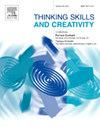基于stem的数字化学习环境中创造性思维与成果的关系:一个混合方法案例研究
IF 3.7
2区 教育学
Q1 Social Sciences
引用次数: 0
摘要
在过去几年中,技术和数字方法越来越多地融入教育,提供了新的学习形式。然而,目前尚不清楚和难以评估这种技术整合如何影响儿童的智力能力和他们的学习动机。本研究的目的是评估和评价创造性思维技能的关键指标对提高学习科学、技术、工程和数学(STEM)的成就和动机的影响。在这项研究中,作者旨在确定3至6岁的儿童是否能够为数字环境中的学习困难提供创造性的解决方案。此外,作者已经确定并评估了儿童的行为,提高他们的学习成绩和动机。为了实现这一目标,采用了混合方法的案例研究方法,结合了定量和定性分析技术。采用“分析儿童创造性思维”(ACCT)框架调查和确定关键创造性思维技能指标的影响。此外,学习动机策略问卷(MSLQ)用于评估儿童在基于stem的数字化学习环境中的认知和动机。研究结果表明,基于stem的数字化学习有可能影响学生培养创造性技能和批判性思维的能力,并培养积极的学习态度,这可能会带来深刻而有意义的学习体验。在stem学习环境中,儿童在游戏前和游戏后的精神运动测试结果显示了参与游戏的儿童在学习过程中精细运动技能的典型发展特征。这项研究可能会为家长、教师和研究人员提供宝贵的见解、建议和建议,以帮助他们在数字环境中提高创造性技能和改善学习成果。本文章由计算机程序翻译,如有差异,请以英文原文为准。
Relationship between creative thinking and outcomes in a digital STEM-based learning environment: A mixed methods case study
Over the past few years, technology and digital methods have been increasingly integrated into education, offering new forms of learning. However, it remains unclear and difficult to assess how this integration of technology may impact children's intellectual capacities and their motivation for learning. The purpose of this research is to assess and evaluate the effect of key indicators for creative thinking skills on increased achievement and motivation in learning Science, Technology, Engineering, and Mathematics (STEM). In this study, the authors aim to determine whether children aged between 3 and 6 can provide creative solutions for learning difficulties in a digital environment. Moreover, the authors have identified and assessed children's behaviors that enhance their learning achievement and motivation. To achieve this, a mixed-methods case study approach was employed, combining quantitative and qualitative analysis techniques. The "Analyzing Children's Creative Thinking" (ACCT) framework was used to investigate and identify the impact of key creative thinking skills indicators. Additionally, Motivational Strategies for Learning Questionnaires (MSLQ) were used to evaluate children's perceptions and motivation in the digital STEM-based learning environment. The findings indicate that digital STEM-based learning has the potential to influence students' ability to develop creative skills and critical thinking, as well as foster positive attitudes toward learning, which may lead to deep and meaningful learning experiences. The results of psychomotor testing of children before and after playing in the STEM-based learning environment demonstrate the typical developmental profile of fine motor skills during learning for the participating children. This research may provide parents, teachers, and researchers with valuable insights, recommendations, and suggestions on how to enhance creative skills and improve learning outcomes in the digital environment.
求助全文
通过发布文献求助,成功后即可免费获取论文全文。
去求助
来源期刊

Thinking Skills and Creativity
EDUCATION & EDUCATIONAL RESEARCH-
CiteScore
6.40
自引率
16.20%
发文量
172
审稿时长
76 days
期刊介绍:
Thinking Skills and Creativity is a new journal providing a peer-reviewed forum for communication and debate for the community of researchers interested in teaching for thinking and creativity. Papers may represent a variety of theoretical perspectives and methodological approaches and may relate to any age level in a diversity of settings: formal and informal, education and work-based.
 求助内容:
求助内容: 应助结果提醒方式:
应助结果提醒方式:


